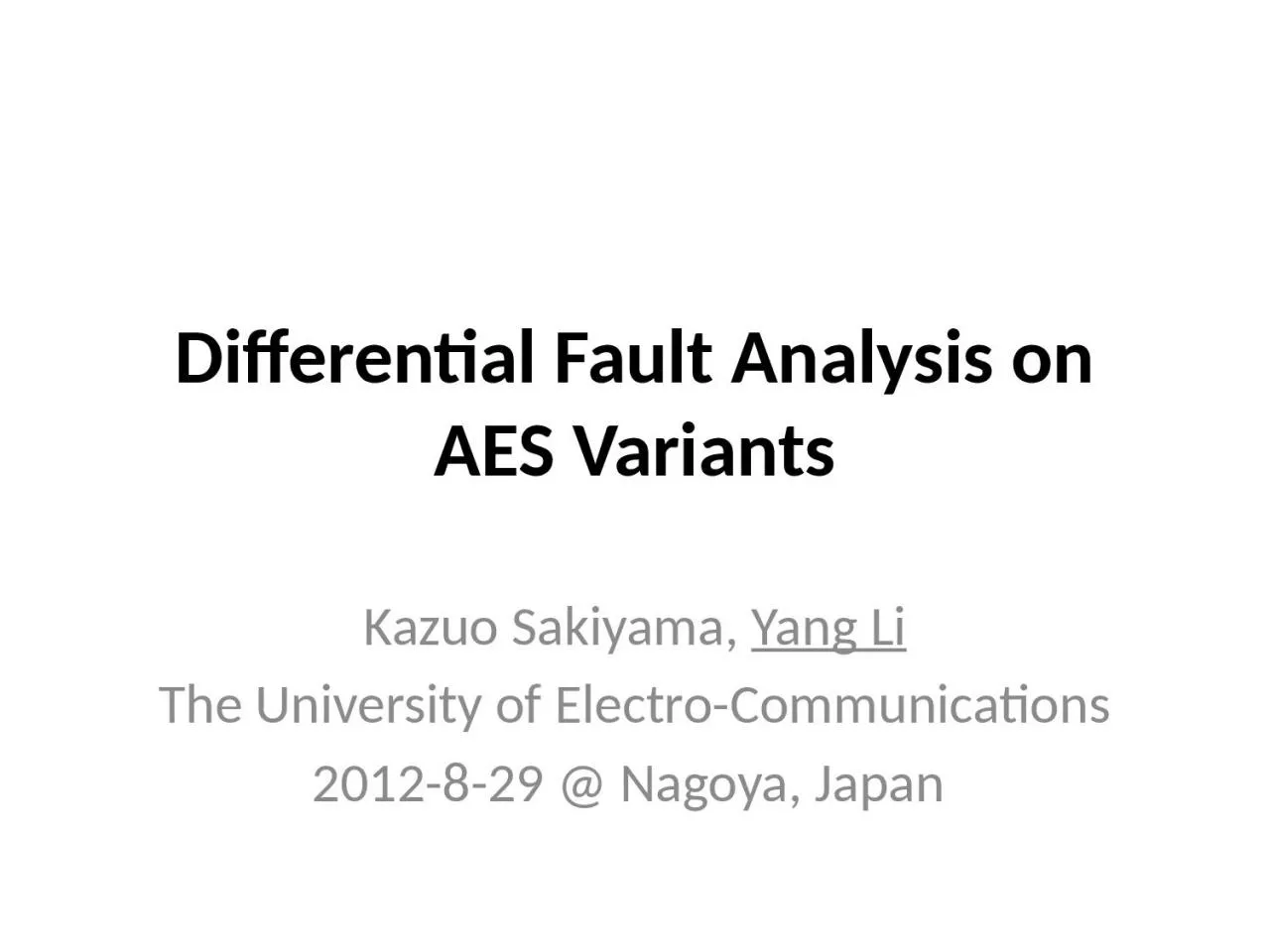

Kazuo Sakiyama Yang Li The University of ElectroCommunications 2012829 Nagoya Japan Contents Background Physical Attacks and Differential Fault Analysis Advanced Encryption Standard ID: 1033877
Download Presentation The PPT/PDF document "Differential Fault Analysis on AES Varia..." is the property of its rightful owner. Permission is granted to download and print the materials on this web site for personal, non-commercial use only, and to display it on your personal computer provided you do not modify the materials and that you retain all copyright notices contained in the materials. By downloading content from our website, you accept the terms of this agreement.
1. Differential Fault Analysis on AES VariantsKazuo Sakiyama, Yang LiThe University of Electro-Communications2012-8-29 @ Nagoya, Japan
2. ContentsBackgroundPhysical Attacks and Differential Fault AnalysisAdvanced Encryption StandardFault Model in this discussion1-byte random fault in known byte positionDFA Attack on AES VariantsDFA on AES-128 with 1 fault injection DFA on AES-192 with 3/2 fault injections DFA on AES-256 with 3/2 fault injectionsChallenge to be practically feasibleConclusion
3. Cryptanalytic AttacksMathematical ApproachPhysical Approach Keep the proposed attack feasible 3 =?Physical Information ChannelsInputOutputCryptographic device(Secret key inside)InputOutput =?InputOutput
4. Classification of Physical AttacksDirection of information channel4 =?Cryptographic device(Secret key inside)InputOutputPassive AttacksActive AttacksInput, Output KnownNon-Invasive Passive Attacks(Side-Channel Analysis)Time, Power Consumption,Electromagnetic RadiationNon-Invasive Active Attacks(Fault Analysis)Inject computational faults
5. Differential Fault Analysis (DFA) on AES EncryptionDFA (Most discussed fault analysis)Attack Procedures 5PAES AESC’CII’IΔI = I I’ C’CKey Guess: KgAES DecryptionAES DecryptionKg-based Correct Intermediate Value: IgKg-based FaultyIntermediate Value: I’gΔIgΔIMatch?PFault Model: Space of ΔIe.g. 1-byte random fault at a known byte position
6. Advanced Encryption StandardSubstitution permutation network Symmetric algorithm128-bit input block3 versions 128-bit key (10 Rounds)192-bit key (12 Rounds)256-bit key (14 Rounds)SBSRMCAKAES Round Operation
7. AES Key ScheduleFK0K1… …K10AES-128FK0… …K12AES-192K1K2
8. AES Key ScheduleF… …K13AES-256SubWordK0K1K3K2K14
9. Fault Model in this presentationFault model: 1-byte random fault modelRandom faulty value at a known byte position 1 S-box calculation has a faulty resultFault injection based on setup-time violationClock glitchLess time for a certain clock cycle (round operation)
10. DFA attacks on AES VariantsThe minimal times of fault injections but still within a practical key recovery complexity DFA on AES-128 with 1 fault injectionCHES03, Africa09, WISTP11DFA on AES-192 with 3 fault injectionsFDTC11DFA on AES-256 with 3 fault injectionsFDTC11DFA on AES-192 with 2 fault injectionsImproved a little from FDTC11DFA on AES-256 with 2 fault injectionsIEEE Trans. on Info. F&S
11. DFA on AES-128SB8SR8MC8AK8SB93412SR93412MC91423142314231423AK9SB10SR10AK10142314231423142314231423142314233241213414234312CC’2-82322823228232282322821282820Without considering K9, we can reduce K10 space to 232
12. DFA Attacks on AES-192 (simple attack, 3 faults) SB9SR9MC9AK9SB10SR10MC10AK10SB11SR11MC11AK11SB12SR12AK12C1C1’SB9SR9MC9AK9SB10SR10MC10AK10SB11SR11MC11AK11SB12SR12AK12C2C2’SB9SR9MC9AK9SB10SR10MC10AK10SB11SR11MC11AK11SB12SR12AK12C3C3’Identify K12 first using (C1,C1’) and (C1,C2’), then recover K11
13. DFA Attacks on AES-256 (simple attack, 3 faults) SB11SR11MC11AK11SB12SR12MC12AK12SB13SR13MC13AK13SB14SR14AK14C1C1’SB11SR11MC11AK11SB12SR12MC12AK12SB13SR13MC13AK13SB14SR14AK14C3C3’SB11SR11MC11AK11SB12SR12MC12AK12SB13SR13MC13AK13SB14SR14AK14C2C2’Identify K14 first using (C1,C1’) and (C1,C2’), then recover K13
14. Space of KgMaybe 2 faults are enough for AES-192 and AES-256C’CKey Guess: KgAES DecryptionAES DecryptionKg-based Correct Intermediate Value: IgKg-based FaultyIntermediate Value: I’gΔIgΔIMatch?Space of ΔISatisfy zero-difference bytesin intermediate statusAES 128: 128-bit 8-bit AES 192: 192-bit 72-bit 0 bitAES 256: 256-bit 136-bit 16-bitKeep the proposed attack feasible!
15. DFA Attacks on AES-192 (2 faults) SB9SR9MC9AK9SB10SR10MC10AK10SB11SR11MC11AK11SB12SR12AK12C1C1’SB9SR9MC9AK9SB10SR10MC10AK10SB11SR11MC11AK11SB12SR12AK12C2C2’Restrict K12 to 232
16. Some property for AES-192 key ScheduleFK10K12AES-192K11For AES-192:K12left 2 columns of K11K12right 1 column of K10
17. DFA Attacks on AES-192 (2 faults) SB9SR9MC9AK9SB10SR10MC10AK10SB11SR11MC11AK11SB12SR12AK12C1C1’SB9SR9MC9AK9SB10SR10MC10AK10SB11SR11MC11AK11SB12SR12AK12C2C2’Restrict K12 to 232Given a K12 candidate, leftmost 2 columns of K11 is fixed, we have 5 more 2-8 conditions to satisfy. So we can identify K12Identify the rest of K11SB11SR11MC11AK11MC10AK10SB11SR11MC11AK11MC10AK10
18. DFA Attacks on AES-256 (2 faults) Restrict K14 to 232SB11SR11MC11AK11SB12SR12MC12AK12SB13SR13MC13AK13SB14SR14AK14C2C2’SB11SR11MC11AK11SB12SR12MC12AK12SB13SR13MC13AK13SB14SR14AK14C1C1’
19. AES S-box Differential TableFor an AES S-box, given a pair of input/output difference, this difference exists with probability of about ½. If this difference pair exist, one can find 2 pairs of solution.Given N pairs of input/output difference, we can expect N real value solutions Used in the inbound of Rebound AttackOutbound Inbound Outbound
20. Some property for AES-256 key ScheduleFAES-256K12K13K14For AES-256:K12right 3 columns of K12
21. DFA Attacks on AES-256 (2 faults) Restrict K14 to 232Pick up a K14, calculate the difference at SB13out, and restrict real values in each column to 28 Then we know the rightmost 3 columns of K12, calculate the blue bytes in SB12in, check 2 conditions of 2-8. Space of SB13out is reduced to 216. Then K13 is reduced to 216(Complexity about 248, key recovery using FPGA takes 8 days to finish) MC12AK12SB13SR13SB11SR11MC11AK11SB12SR12MC12AK12SB13SR13MC13AK13SB14SR14AK14C2C2’SB11SR11MC11AK11SB12SR12MC12AK12SB13SR13MC13AK13SB14SR14AK14C1C1’MC12AK12SB13SR13SR12SB12AK11MC11
22. ConclusionIn side-channel attacks especially fault analysis, cryptanalysis techniques can help.For AES-256, DFA attack with two 1-byte random faults at known position are feasible for strong attackersCan we make DFA with unknown positions faults feasible?
23. Thank you for your attentions!